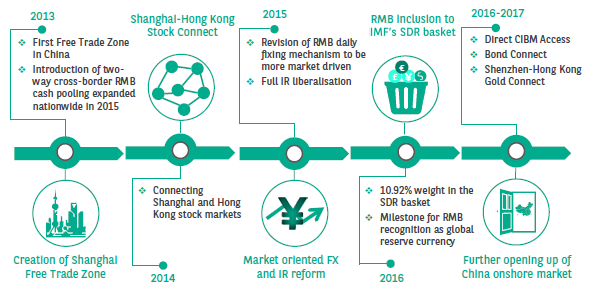
China has dramatically accelerated its efforts to open its financial markets to outside influence, with recent inclusion of Chinese A-shares into the MSCI Emerging Market equity index and FTSE Russell saying it will follow suit, the imminent opening of the London-Shanghai Stock Connect Scheme and China’s bond markets poised for inclusion into the Bloomberg Barclays Global Bond Index next April. After years of signals that real change was imminent, there is now no question for global investors around when to enter China. Big shifts are taking place in investor portfolios across the globe following these major announcements.
FTSE Russell said in late September it would look for Chinese A-shares to comprise 5.5 per cent of the FTSE Emerging Index, including around 1200 Chinese firms in three stages commencing in June 2019. FTSE Russell said this would represent initial passive inflows of $10bn in assets under management. At the same time, MSCI said it is studying three key topics:
- Increasing the inclusion factor of MSCI China A Large Cap securities from 5 per cent to 20 per cent of their respective free float-adjusted market capitalisations in two phases coinciding with the May 2019 Semi-Annual Index Review and August 2019 Quarterly Index Review;
- Adding the ChiNext board of the Shenzhen Stock Exchange to the list of eligible stock exchange segments starting from the May 2019 Semi-Annual Index Review;
- Adding China A Mid Cap securities with a 20 per cent inclusion factor in one phase as part of the May 2020 Semi-Annual Index Review.
Weight of A-shares in MSCI EM index is expected to grow from the initial less than one per cent (contributed by 235 stocks) over time, says Manishi Raychaudhuri, Head of Equity Research for Asia Pacific at BNP Paribas.
“If and when the inclusion factor of 5 per cent goes to 100 per cent the weight of A-shares in the MSCI Emerging Market will go to a little more than 16 per cent from 0.81 per cent currently. I use the word ‘if’ because there are certain conditions that need to be satisfied for the inclusion factor to increase,” says Mr Raychaudhuri.
He says predicting “when” is dependent on China’s ability to address two key issues.
“Index providers would like to see a significant degree of decline in the number of stock suspensions and number of days over which the stock is suspended. They are also looking at the access avenues being expanded considerably. In this context it’s encouraging that stock suspensions in onshore China have been declining lately and MSCI also pointed this out in its recent communication. Increase in the weight of A-shares and the weight of China overall in benchmark indices should drive significant foreign flows into onshore China equities, particularly because foreign ownership of Chinese equities is much lower than that of other Asian markets. Progressive increase in A-shares’ weight should correct such under-ownership,” says Mr Raychaudhuri.
Jason Lui, Head of Equity and Derivative Strategy Asia Pacific at BNP Paribas says global equity investors can be broadly categorised into three camps at this time of momentous change.
“First we have the passive funds that follow the index and will be focused on execution. Then there are the active managers that already have some exposure to China but after inclusion they’re not sure how the passive flows are going to help or hurt their portfolios,” says Mr Lui.
The last group are those that would prefer not to be in China at all, daunted by the unknown and not sure exactly where and how to build a position.
These investors can’t afford to wait on the sidelines any longer and that is why inclusion, and the expectation that weightings toward Chinese A-shares will continue to build, make it such an exciting time.
Jason Lui, Head of Equity and Derivative Strategy Asia Pacific at BNP Paribas.
A small beginning with a long-term impact
From June 1 2018, 233 large cap China A-shares will be added to the MSCI Emerging Markets (EM) Index from an initially-proposed number of 222. Foreign institutional investors’ increasing participation in A-shares could create opportunities and help institutionalise the domestic market.The China A-Share market is the most active cash equity market in Asia Pacific with US$48 billion of average turnover per day meaning most of the constituents for MSCI C inclusion have good liquidity, with three quarters of the stocks trading more than US$50 million per day.
“We expect up to US$20 billion worth of passive and active index rebalance inflow,” says Mr Lui. “Not only will this boost China’s creditability as a global economic power, but it will also help to increase global fund inflows into the domestic market.”
While this is just a small beginning, it has a potentially long-term impact where the ramifications of A-Share inclusion are manifold:
- Not only is A-Share inclusion an important step towards internationalisation of the RMB, it should also serve as a prompt for international investors to look at A shares more closely.
- The A-shares that are being considered for inclusion are from sectors significantly different to those comprising MSCI China or HSCEI. With an increasing inclusion factor, the universe of Chinese stocks available to international investors would be considerably different to that available today.
- MSCI’s methodology for inclusion of A-shares in its set of eligible stocks ensures an incentive for trading processes in onshore Chinese equity markets to become more sophisticated – e.g. trading suspensions could be reduced considerably.
The Chinese bond market is too big to be ignored
China’s financial sector is ready for further inroads by foreign investors and in its latest effort to develop its bond market, Chinese RMB-denominated government and policy bank securities are set to join the Bloomberg Barclays Global Bond Index for the first time in 2019. The addition of these securities to the world’s second-largest bond market will be phased in over a 20-month period, with a scaling factor of 5% and increasing in 5% increments each month following, and will represent 5.49% of the index.Marking another milestone in the path to financial sector liberalization, the local currency Chinese bonds will be the fourth largest currency component following the US dollar, euro and Japanese yen. It also signifies confidence from Chinese authorities that domestic financial institutions are strong enough to compete with foreign rivals.
Many global investors have been reluctant to invest in China’s roughly US$12 trillion bond market until now, with international ratings agencies still yet to set up coverage of Chinese corporate debt onshore.
Partly because of poor visibility, Charles Chang, Head of Asia Credit Strategy and Trading Desk Analysts at BNP Paribas says, investing in Chinese domestic bonds is like “looking for treasure in the forest.”
Charles Chang, Head of Asia Credit Strategy and Trading Desk Analysts at BNP ParibasInvesting in Chinese domestic bonds is like looking for treasure in the forest.
“The inclusion of China’s domestic bond market in the global indices is essentially like shining a flashlight on that market, which previously is not visible to international investors. So, the importance is much more about visibility and transparency, which encourages participation, and is, at the end of the day, the basic requirement for involvement,” he says.
Currently, Emerging Market (EM) investors are parking their assets elsewhere.
“Most EM portfolios, whether it’s in London or in the US, have an average allocation to Asia of about 10 to 15 per cent, even though the index they track has Asia at about 20 to 30 per cent, which is to say they have been heavily underweight Asia for quite a long time,” Mr Chang says.
“Latin America has been heavily over-weighted, even though Asia has much shorter duration, which means much less interest rate risk. We are in a period with ongoing rate hikes from the fed – there were three last year, and there’s probably going to be three or four this year. So for fund managers, the big question is: how do I deal with interest rate risks? By allocating to Asia, you are essentially reducing your interest rate risks,” says Mr Chang.
China’s inclusion in global bond indices, and the government’s continued financial sector reforms, could drive more interest from international investors, which could pave the way for more participation in China’s domestic bond market.
“International investors’ interest now is based on two factors – more attractive onshore yields, and the rising strategic importance of China’s financial markets,” says Mr Chang.
However, despite rising inflows from overseas into Chinese bonds last year, foreigners still own less than 2% of the Chinese bond market, with a high proportion of that figure made up of overseas subsidiaries of Chinese institutions such as the nation’s top banks and brokerages.
In August, the Hong Kong Exchange announced the resolution of two of the three main conditions for inclusion into the benchmark Bloomberg-Barclays Aggregate Index – upgrading the Bond Connect settlement system to fully implement real-time delivery versus payment (DVP) and introducing block trade allocations and reduced trading sizes.
“The third, a clarification on taxes from Chinese regulators that provides a three-year grace period for offshore bond investors, paves the way for Mainland bonds to be included in the Bloomberg-Barclays index next April and potentially other global benchmarks soon,” Mr Li said in a statement.
“The market believes real-time DVP alone will generate greater interest from central banks and other active investors that could drive US$500 billion Northbound [into China], and index inclusion could send another US$100 billion through Bond Connect into China’s interbank bond market. This represents a major breakthrough for Bond Connect and our overall fixed income strategy.”
From an access point of view, Julien Kasparian, Head of BNP Paribas Securities Services in Hong Kong, says work continues to improve investor confidence. “These recent developments to Bond Connect will be important for investors to gain comfort that the investment risks are manageable and could be a key factor in encouraging indices to add or increase China weightings,” says Mr Kasparian.

